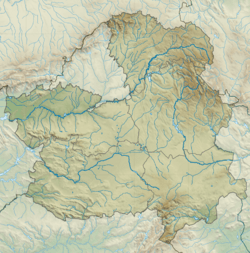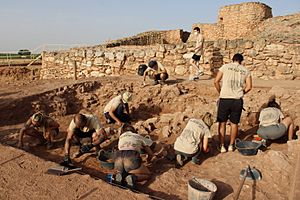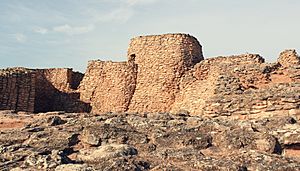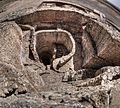Motilla del Azuer facts for kids
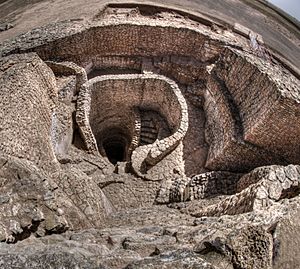
Overhead view in August 2016
|
|
| Location | Daimiel, in the Province of Ciudad Real, Spain |
|---|---|
| Region | Castilla–La Mancha |
| Coordinates | 39°02′36″N 3°29′51″W / 39.04333°N 3.49750°W |
| History | |
| Founded | Bronze Age |
| Site notes | |
| Public access | Open to the public |
| Official name | Motilla del Azuer |
| Type | Non-movable |
| Criteria | Zona Arqueológica |
| Designated | 20 June 2013 |
The Motilla del Azuer is an ancient fort from the Bronze Age. It is located in Daimiel, a town in the Province of Ciudad Real, Castilla–La Mancha, Spain.
Archaeologists have been working at this site since 1974. They were still doing field work in 2021. On June 20, 2013, the site was officially named a "Bien de Interés Cultural". This means it is an important cultural treasure for archaeology in Spain.
Contents
What are Motillas?
Motillas are special artificial mounds. They are the remains of unusual prehistoric settlements found in the La Mancha region of Spain. These mounds date back to the Bronze Age, from about 2200 to 1500 BCE.
These mounds are usually between 4 and 10 meters (13 to 33 feet) high. They were originally strong forts with a central design and many layers of walls. Motillas are often found about 4 to 5 kilometers (2.5 to 3 miles) apart. They are in flat areas near rivers, where there used to be many lagoons and marshes.
The Motilla del Azuer is very special because of its massive walls. Some walls are more than 8 meters (26 feet) high. This makes it one of the most important Bronze Age sites on the Iberian Peninsula.
Why were Motillas Important?
During the Bronze Age, these fortified settlements were very important. They helped manage and control the local economy. Inside the walls, people had access to water from a well. They also stored and processed large amounts of grains. Livestock were kept safe, and people made pottery and other crafts there.
Exploring Motilla del Azuer
The mound at Azuer is about 40 meters (130 feet) wide. It has a tall tower, three layers of walls, and a large courtyard. The main part is a square tower made of stone. Its east and west walls are still over 10 meters (33 feet) high. To get inside, people used ramps within narrow stone corridors.
Inside the Walls
Within the fort's walls are large open areas. There is a patio and two big enclosed spaces. In the patio, there is a well that goes deep into the ground to reach the water. This well was used throughout the time people lived there. Today, it is still at least 16 meters (52 feet) deep.
The middle enclosed area is on the western side of the fort. Its purpose changed over time. Sometimes it was used to keep sheep, goats, and pigs. Other times, it was a storage area for barley and wheat. Early on, they used rectangular silos made of stone and mud. Later, they stored grains in large pots and baskets made from esparto grass.
Outer Walls and Living Areas
The outermost walls are very interesting. Parts of them have fallen inwards, which helps archaeologists understand how they were built. Inside the area between the outer and middle walls, there are many round or oval ovens. These ovens had stone bases and clay tops. There were also rectangular silos for grain, built over many years.
The very outer circular wall was made of huge limestone blocks in its final stage. People entered the fort from the living area outside through corridors that ran along the walls. The houses were located outside the main fort, within about 50 meters (164 feet). These houses were oval or rectangular. They had stone bases, clay walls, and wooden posts. Near the houses were large open areas for storage and work. These areas had many pits and remains of fireplaces or ovens. There were also areas where people threw away their trash.
The Cemetery at Motilla del Azuer
There is also a cemetery at the site. It covers most of the settlement area. This was common in many cultures on the Iberian Peninsula during the Bronze Age. People were buried in a crouching position. They were placed in simple graves or graves lined with stone walls or slabs. Sometimes, graves were built next to house walls or the outer defensive walls.
Some children were buried in pots. Not many items were buried with the dead. However, some adults were found with ceramic pots. Other special finds include a dagger with copper and arsenic rivets and a metal punch.
Archaeological Discoveries and Restoration
Since 1974, a team from the University of Granada has been working at Motilla del Azuer. The team is led by Trinidad Nájera Colino and Fernando Molina González. By 2021, they had completed fourteen seasons of archaeological work. The first phase of research lasted until 1986. After a break, field work started again in 2000 and continued in 2021.
This work has also led to projects that strengthen and repair the ancient structures.
In 2014, a study looked at the water systems. It found a link between the ground and where the motillas were built. It suggested that these motillas might be the oldest system for collecting underground water in Iberia. The study concluded that motillas were built during a time of severe drought around 4,200 years ago. Building defended settlements around wells was a successful solution. This helped people survive for about a thousand years and led to a more organized society.
Images for kids
See also
 In Spanish: Motilla del Azuer para niños
In Spanish: Motilla del Azuer para niños


